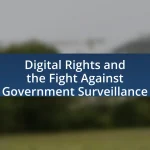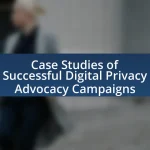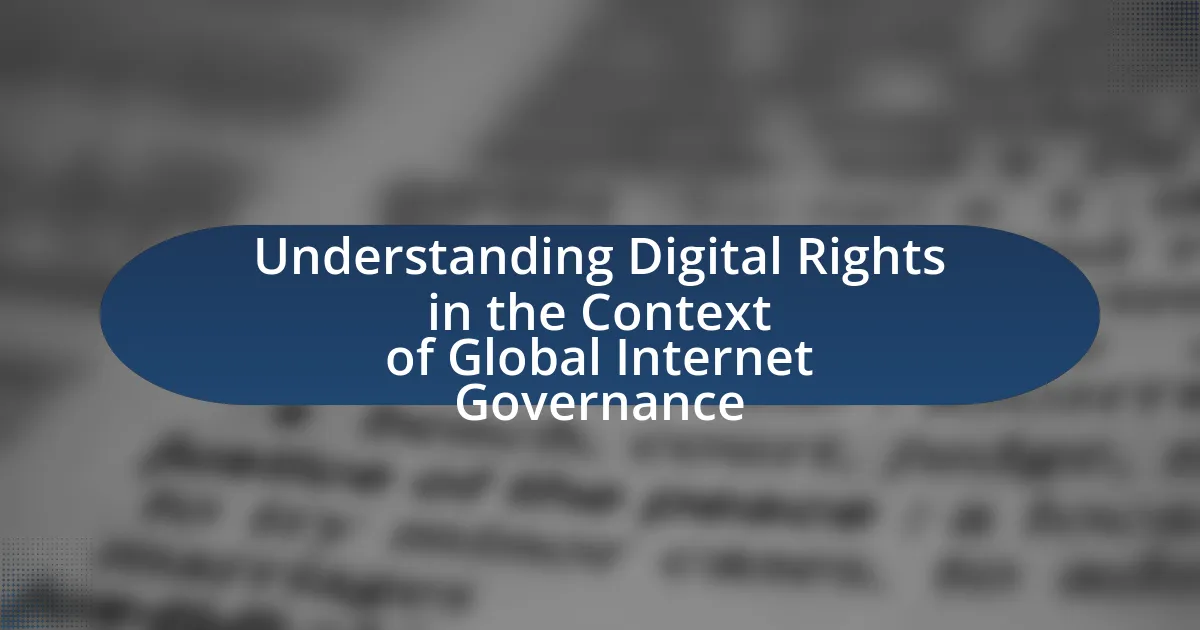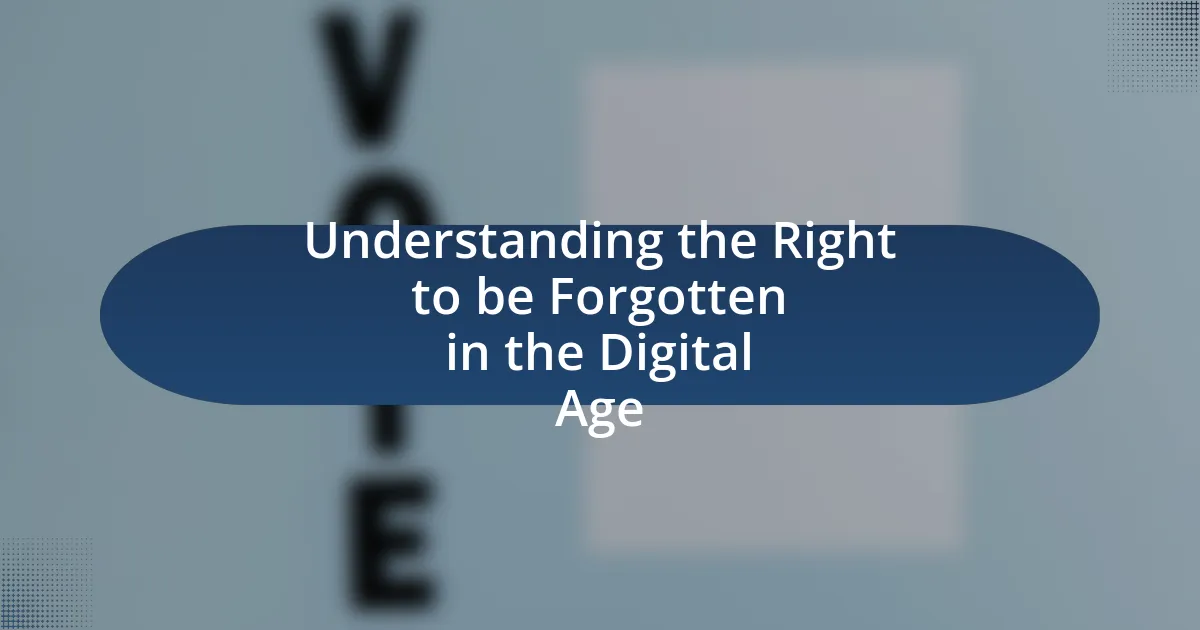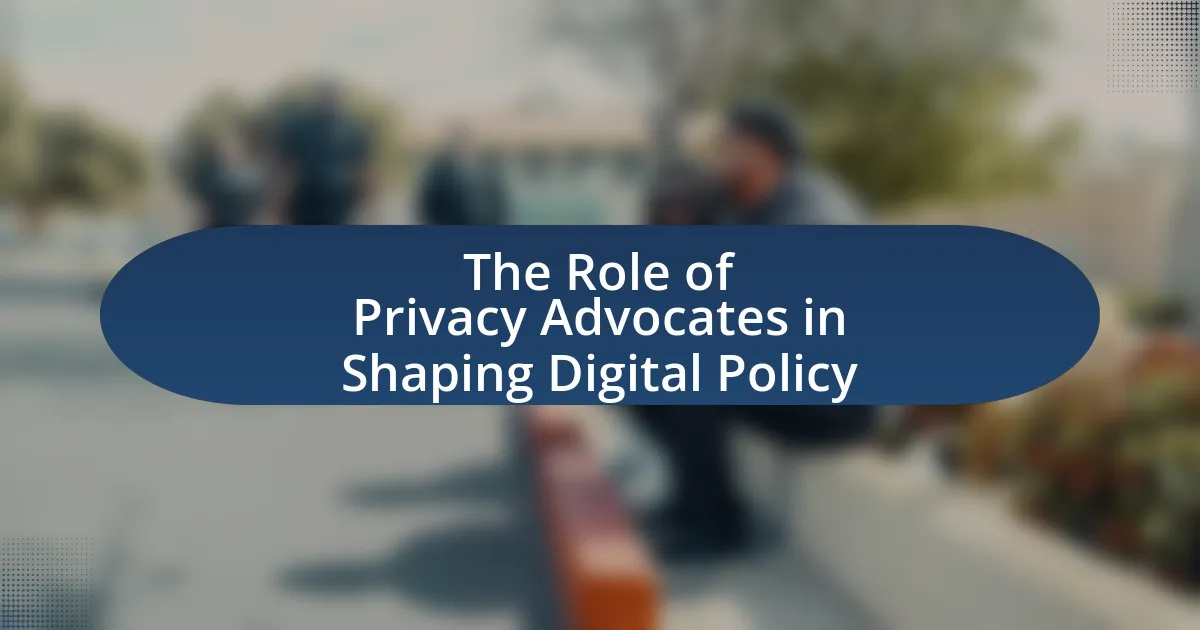Digital rights encompass the legal and ethical entitlements individuals have regarding their online presence, data privacy, and access to information. These rights are particularly vital for marginalized communities, who often face systemic inequalities that limit their access to technology and information. The article explores how digital rights impact these communities by ensuring access to information, freedom of expression, and protection from discrimination. It highlights the specific challenges marginalized groups encounter, such as limited access to technology and inadequate digital literacy, and discusses the implications of digital divides on education and employment opportunities. Furthermore, the article emphasizes the role of digital rights in promoting social justice and equality, while outlining strategies for advocacy and community engagement to enhance protections for these vulnerable populations.
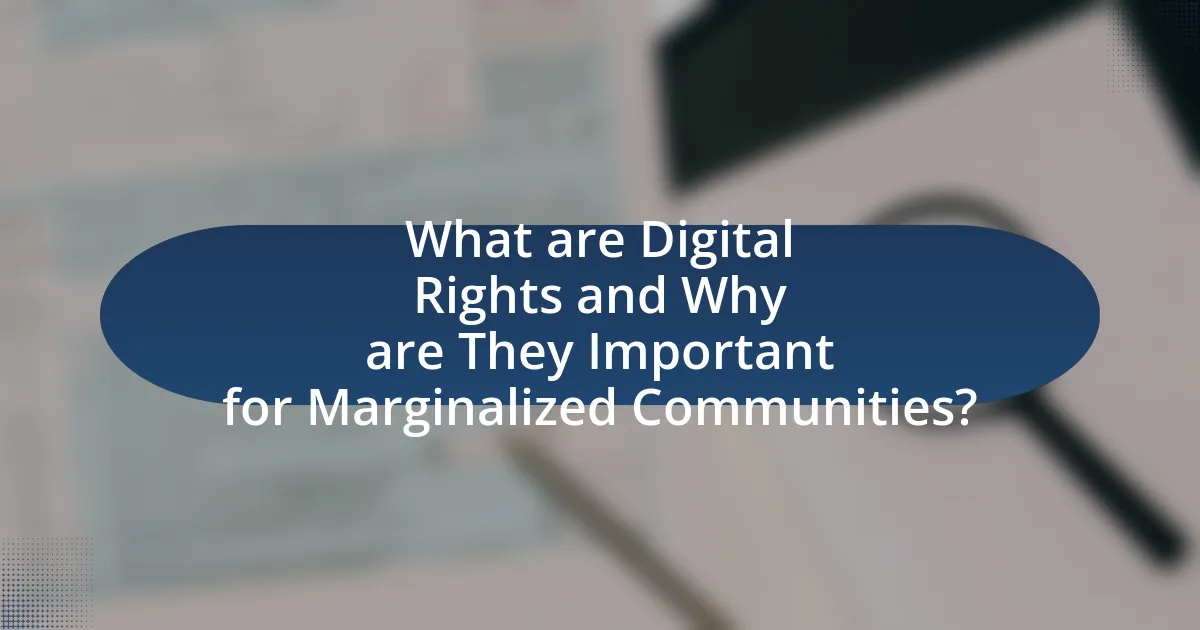
What are Digital Rights and Why are They Important for Marginalized Communities?
Digital rights refer to the legal and ethical entitlements individuals have regarding their online presence, data privacy, and access to information. These rights are crucial for marginalized communities as they often face systemic inequalities that limit their access to technology and information. For instance, according to the United Nations, over 3 billion people globally lack internet access, disproportionately affecting low-income and rural populations. Ensuring digital rights helps empower these communities by providing them with the tools to participate in the digital economy, access essential services, and express their voices. Furthermore, protecting digital rights can prevent discrimination and surveillance, which are prevalent issues for marginalized groups, thereby fostering a more equitable digital landscape.
How do Digital Rights impact the lives of marginalized communities?
Digital rights significantly impact the lives of marginalized communities by ensuring their access to information, freedom of expression, and protection from discrimination online. These rights empower individuals from marginalized backgrounds to participate in the digital economy, access essential services, and engage in social and political discourse. For instance, according to a report by the United Nations, individuals in marginalized communities often face barriers to internet access, which can exacerbate existing inequalities. Furthermore, the lack of digital rights can lead to increased surveillance and censorship, disproportionately affecting these communities. Therefore, the recognition and enforcement of digital rights are crucial for fostering equity and inclusion in the digital landscape.
What specific challenges do marginalized communities face regarding digital rights?
Marginalized communities face significant challenges regarding digital rights, primarily including limited access to technology, inadequate digital literacy, and systemic discrimination in online spaces. Limited access to technology is evidenced by the digital divide, where individuals in low-income areas often lack reliable internet and devices, hindering their ability to participate fully in the digital world. Inadequate digital literacy further exacerbates this issue, as many individuals from marginalized backgrounds may not have the skills necessary to navigate online platforms effectively, leading to exclusion from essential services and information. Additionally, systemic discrimination manifests in various forms, such as biased algorithms and online harassment, which disproportionately affect marginalized groups, undermining their safety and freedom of expression online. These challenges highlight the urgent need for policies that promote equitable access and protect the digital rights of all individuals, particularly those from marginalized communities.
How do digital rights contribute to social justice for these communities?
Digital rights contribute to social justice for marginalized communities by ensuring equitable access to information, communication, and technology. These rights empower individuals to participate fully in the digital economy and society, reducing disparities in education, employment, and civic engagement. For instance, the United Nations has recognized internet access as a fundamental human right, highlighting its role in promoting social inclusion and equality. Furthermore, studies show that marginalized groups with access to digital tools can better advocate for their rights and mobilize for social change, as seen in various grassroots movements that leverage social media for activism.
What are the key components of digital rights?
The key components of digital rights include the right to access information, the right to privacy, the right to freedom of expression, and the right to digital security. These components ensure that individuals can freely access and share information online, protect their personal data from unauthorized use, express their opinions without censorship, and safeguard their digital identities against threats. For instance, the United Nations has recognized access to the internet as a fundamental human right, emphasizing its importance for participation in society and the economy.
What rights are included under the umbrella of digital rights?
Digital rights encompass a range of rights that ensure individuals can access, use, create, and share digital content freely and safely. These rights include the right to internet access, the right to privacy online, the right to freedom of expression, the right to data protection, and the right to digital literacy. For instance, the United Nations has recognized internet access as a fundamental human right, emphasizing its importance for participation in society and the economy. Additionally, privacy rights are protected under various laws, such as the General Data Protection Regulation (GDPR) in Europe, which safeguards personal data and privacy. These rights are crucial for marginalized communities, as they help to bridge the digital divide and promote equitable access to information and resources.
How do these rights differ for marginalized communities compared to others?
Digital rights for marginalized communities often differ significantly from those of other groups due to systemic inequalities and barriers to access. Marginalized communities frequently face greater challenges in exercising their digital rights, such as limited access to technology, internet connectivity, and digital literacy resources. For instance, a report by the Pew Research Center indicates that Black and Hispanic households in the United States are less likely to have high-speed internet access compared to their white counterparts, which directly impacts their ability to engage fully in the digital landscape. Additionally, marginalized groups often encounter heightened surveillance and discrimination online, which can further restrict their rights to privacy and freedom of expression. These disparities highlight the urgent need for targeted policies and initiatives to ensure equitable digital rights for all communities.
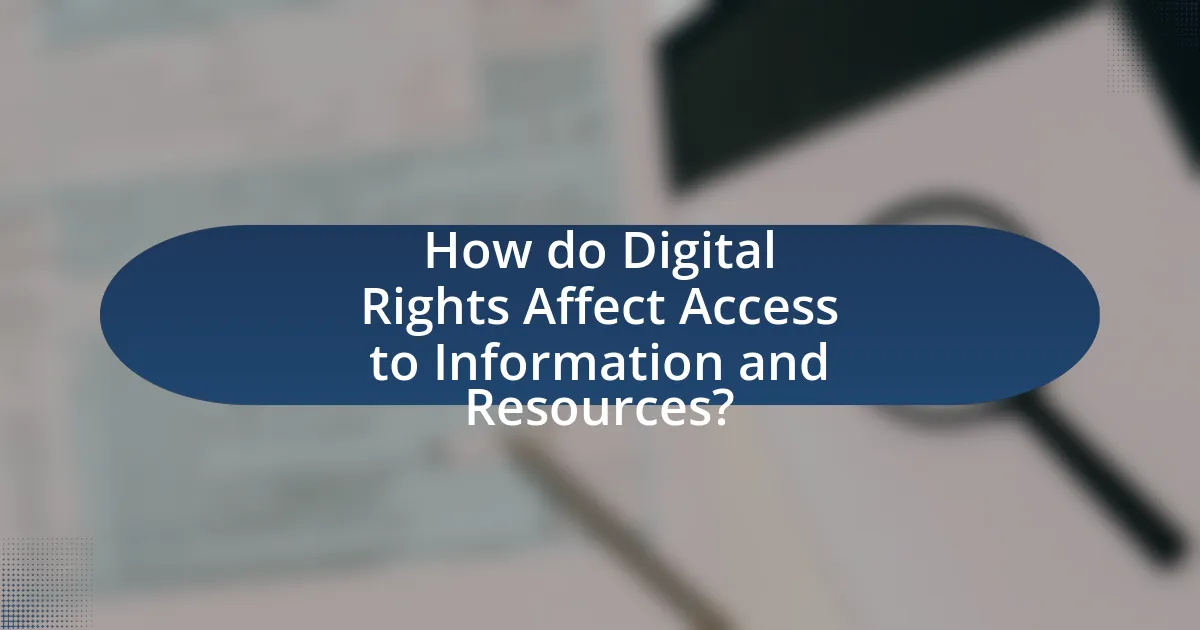
How do Digital Rights Affect Access to Information and Resources?
Digital rights significantly influence access to information and resources by ensuring individuals can freely engage with digital content without undue restrictions. These rights protect users from censorship, surveillance, and data exploitation, which can limit their ability to access vital information. For instance, the United Nations recognizes internet access as a human right, emphasizing that restrictions can disproportionately affect marginalized communities, hindering their access to educational resources, healthcare information, and civic engagement opportunities. Studies show that when digital rights are upheld, there is a marked increase in participation and empowerment among these communities, as they can leverage online platforms for advocacy and support.
What role does access to information play in empowering marginalized communities?
Access to information is crucial for empowering marginalized communities as it enables them to make informed decisions, advocate for their rights, and participate actively in societal processes. When marginalized groups have access to relevant information, they can challenge systemic inequalities, mobilize resources, and engage in political discourse. For instance, studies show that access to information about legal rights and social services significantly increases the ability of marginalized individuals to seek justice and support. According to the Pew Research Center, communities with better access to information technology report higher levels of civic engagement and social cohesion, demonstrating that information access directly correlates with empowerment and improved community outcomes.
How does limited access to digital resources affect education and employment opportunities?
Limited access to digital resources significantly hinders education and employment opportunities for marginalized communities. This lack of access restricts individuals from utilizing online learning platforms, which are essential for acquiring new skills and knowledge. According to a report by the Pew Research Center, 15% of Americans do not have access to high-speed internet, which directly correlates with lower educational attainment and job prospects. Furthermore, the World Economic Forum highlights that digital skills are increasingly required in the job market; without access to digital tools, individuals are less competitive for employment opportunities. Thus, limited digital access perpetuates cycles of poverty and inequality, making it difficult for marginalized groups to improve their socio-economic status.
What are the implications of digital divides on marginalized groups?
Digital divides significantly hinder marginalized groups by limiting their access to essential resources and opportunities. These groups often face barriers such as inadequate internet connectivity, lack of digital literacy, and insufficient access to technology, which exacerbate existing inequalities. For instance, a report by the Pew Research Center indicates that 25% of Black and Hispanic households in the United States lack high-speed internet access, compared to only 10% of white households. This disparity restricts their ability to participate in online education, access healthcare services, and engage in the job market, ultimately perpetuating cycles of poverty and social exclusion.
How can digital rights promote equality and inclusion?
Digital rights can promote equality and inclusion by ensuring that all individuals have equal access to the internet and digital technologies, which are essential for participation in modern society. Access to digital resources enables marginalized communities to engage in economic, educational, and social opportunities that would otherwise be unavailable. For instance, the Internet Society reports that increased internet access can lead to improved economic outcomes, with studies showing that every 10% increase in broadband penetration can boost GDP by 1.38% in developing countries. Furthermore, digital rights protect individuals from discrimination and ensure their voices are heard in digital spaces, fostering a more inclusive environment. By advocating for policies that uphold these rights, societies can work towards reducing inequalities and enhancing the representation of marginalized groups in the digital landscape.
What initiatives exist to support digital rights for marginalized communities?
Initiatives that support digital rights for marginalized communities include the Digital Rights Initiative, which advocates for equitable access to technology and internet services, and the Electronic Frontier Foundation, which provides legal support and resources to protect digital privacy and free expression. Additionally, organizations like Access Now work to ensure that marginalized groups have a voice in policy discussions affecting their digital rights. These initiatives are crucial as they address systemic inequalities and promote inclusivity in the digital landscape, ensuring that all communities can participate fully in the digital economy and society.
How can technology be leveraged to enhance digital rights awareness?
Technology can be leveraged to enhance digital rights awareness by utilizing online platforms, social media campaigns, and educational tools to disseminate information. For instance, organizations can create interactive websites and mobile applications that provide resources on digital rights, making the information accessible to a broader audience. According to a report by the Electronic Frontier Foundation, social media campaigns have successfully raised awareness about digital privacy issues, reaching millions and prompting discussions on digital rights. Additionally, webinars and online courses can educate marginalized communities about their rights, empowering them to advocate for themselves in the digital space.
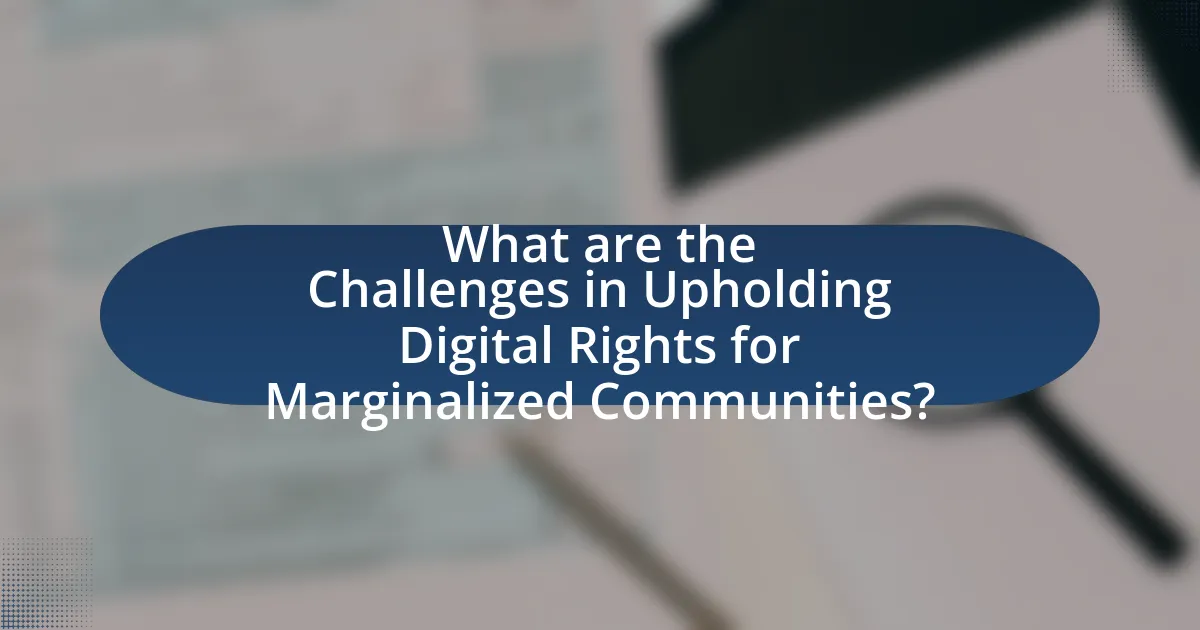
What are the Challenges in Upholding Digital Rights for Marginalized Communities?
Upholding digital rights for marginalized communities faces significant challenges, including systemic inequality, lack of access to technology, and inadequate legal protections. Systemic inequality often results in these communities being disproportionately affected by digital surveillance and data privacy violations, as seen in studies indicating that marginalized groups are more frequently targeted by law enforcement’s digital monitoring practices. Additionally, lack of access to technology limits their ability to engage with digital platforms, which is crucial for exercising their rights. For instance, a report by the Pew Research Center found that 25% of Black and Hispanic households in the U.S. lack high-speed internet access, hindering their participation in the digital economy. Furthermore, inadequate legal protections fail to address the unique vulnerabilities faced by these communities, as existing laws often do not account for the intersectionality of race, gender, and socioeconomic status, leaving them without recourse against digital rights violations.
What barriers do marginalized communities face in asserting their digital rights?
Marginalized communities face significant barriers in asserting their digital rights, primarily due to systemic inequalities, lack of access to technology, and insufficient legal protections. Systemic inequalities manifest in socioeconomic disparities that limit access to the internet and digital tools, with reports indicating that 25% of low-income households lack broadband access, hindering their ability to engage online. Additionally, the digital divide is exacerbated by inadequate digital literacy programs, which leave many individuals without the skills necessary to navigate digital platforms effectively. Furthermore, existing legal frameworks often fail to protect the rights of these communities, as evidenced by the lack of comprehensive data protection laws that address the unique vulnerabilities faced by marginalized groups. These barriers collectively impede their ability to advocate for their digital rights and participate fully in the digital landscape.
How do systemic inequalities impact the enforcement of digital rights?
Systemic inequalities significantly hinder the enforcement of digital rights by creating barriers that disproportionately affect marginalized communities. These inequalities manifest in various forms, such as socioeconomic status, race, and access to technology, which limit individuals’ ability to exercise their digital rights effectively. For instance, a report by the Pew Research Center indicates that lower-income households are less likely to have reliable internet access, which directly impacts their ability to engage with digital platforms and access online services. Furthermore, systemic biases in law enforcement and regulatory frameworks often lead to unequal protection of digital rights, where marginalized groups face heightened surveillance and discrimination online. This inequity in enforcement not only undermines the digital rights of these communities but also perpetuates a cycle of exclusion and disadvantage in the digital landscape.
What role do governments and corporations play in these challenges?
Governments and corporations play critical roles in the challenges faced by marginalized communities regarding digital rights. Governments are responsible for creating and enforcing laws that protect digital rights, yet many fail to adequately address issues such as surveillance, data privacy, and access to technology. For instance, the lack of comprehensive data protection laws in many countries leaves vulnerable populations exposed to exploitation. Corporations, on the other hand, influence digital rights through their policies and practices, often prioritizing profit over ethical considerations. For example, tech companies may collect and monetize user data without informed consent, disproportionately affecting marginalized groups who may lack the resources to understand or contest these practices. Together, the actions of governments and corporations shape the digital landscape, impacting the rights and freedoms of marginalized communities.
What strategies can be implemented to overcome these challenges?
To overcome the challenges faced by marginalized communities regarding digital rights, implementing comprehensive digital literacy programs is essential. These programs should focus on educating individuals about their rights, online safety, and the use of technology to advocate for themselves. Research indicates that increased digital literacy can empower marginalized groups, enabling them to navigate digital spaces more effectively and assert their rights. For instance, a study by the Pew Research Center found that individuals with higher digital literacy are more likely to engage in online advocacy and access essential services. Additionally, fostering partnerships between community organizations and tech companies can facilitate access to resources and support, further enhancing the ability of marginalized communities to overcome digital rights challenges.
How can advocacy and community engagement improve digital rights protections?
Advocacy and community engagement can significantly improve digital rights protections by mobilizing collective action and raising awareness about the specific challenges faced by marginalized communities. When communities actively participate in advocacy efforts, they can influence policy changes and hold governments and corporations accountable for their digital practices. For instance, the Electronic Frontier Foundation has documented cases where grassroots movements have successfully lobbied for stronger privacy laws and better data protection measures, demonstrating the power of organized community efforts. Furthermore, community engagement fosters education and empowerment, equipping individuals with the knowledge to assert their rights and navigate digital spaces safely. This combination of advocacy and informed community participation leads to more robust digital rights protections tailored to the needs of vulnerable populations.
What best practices can organizations adopt to support marginalized communities in digital rights?
Organizations can adopt several best practices to support marginalized communities in digital rights, including implementing inclusive policy frameworks, providing digital literacy training, and ensuring equitable access to technology. Inclusive policy frameworks should prioritize the voices and needs of marginalized groups, as evidenced by the UN’s Guiding Principles on Business and Human Rights, which emphasize the responsibility of organizations to respect human rights in their operations. Providing digital literacy training empowers individuals from marginalized communities to navigate online spaces safely and effectively, which is crucial given that 25% of adults in low-income areas lack basic digital skills, according to the Pew Research Center. Ensuring equitable access to technology involves addressing barriers such as affordability and infrastructure, as studies show that communities with limited internet access face significant disadvantages in accessing information and services. By focusing on these practices, organizations can create a more equitable digital landscape for marginalized communities.
What are the Future Directions for Digital Rights Advocacy?
Future directions for digital rights advocacy include enhancing privacy protections, promoting equitable access to technology, and advocating for algorithmic transparency. These areas are critical as marginalized communities often face disproportionate risks related to data privacy breaches, digital exclusion, and biased algorithms. For instance, the 2021 report by the Electronic Frontier Foundation highlights that marginalized groups are more likely to be surveilled and targeted by harmful technologies. Additionally, initiatives like the Global Digital Compact proposed by the United Nations aim to establish shared principles for an open, free, and secure digital future, emphasizing the need for inclusive policies that protect the rights of all individuals, particularly those from vulnerable backgrounds.
How can emerging technologies influence the landscape of digital rights?
Emerging technologies can significantly influence the landscape of digital rights by reshaping how data is collected, shared, and protected. For instance, advancements in artificial intelligence and blockchain technology can enhance transparency and accountability in data usage, thereby empowering marginalized communities to assert their digital rights more effectively. According to a report by the Electronic Frontier Foundation, technologies like encryption and decentralized networks can provide individuals with greater control over their personal information, reducing the risk of exploitation and surveillance. Furthermore, the integration of machine learning in policy-making can help identify and address systemic biases, ensuring that digital rights frameworks are inclusive and equitable for all communities.
What role will international cooperation play in advancing digital rights for marginalized communities?
International cooperation will play a crucial role in advancing digital rights for marginalized communities by fostering collaborative frameworks that promote equitable access to technology and protect individuals from digital discrimination. Such cooperation can lead to the establishment of global standards and policies that ensure the protection of digital rights, as evidenced by initiatives like the United Nations’ Sustainable Development Goals, which emphasize the importance of inclusive and accessible technology. Furthermore, partnerships among countries can facilitate knowledge sharing and resource allocation, enabling marginalized communities to gain the necessary tools and support to navigate the digital landscape effectively.
What practical steps can individuals take to support digital rights for marginalized communities?
Individuals can support digital rights for marginalized communities by advocating for inclusive policies and practices that protect online privacy and access. Engaging in community education initiatives helps raise awareness about digital rights issues, while supporting organizations that focus on digital equity can amplify marginalized voices. Additionally, individuals can participate in campaigns that promote legislation aimed at safeguarding digital rights, such as net neutrality laws, which ensure equal access to the internet. Research indicates that marginalized communities often face disproportionate barriers to digital access, highlighting the need for targeted support and advocacy efforts.

